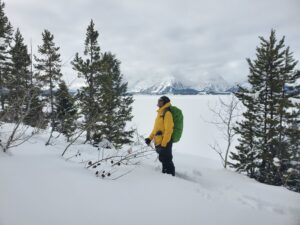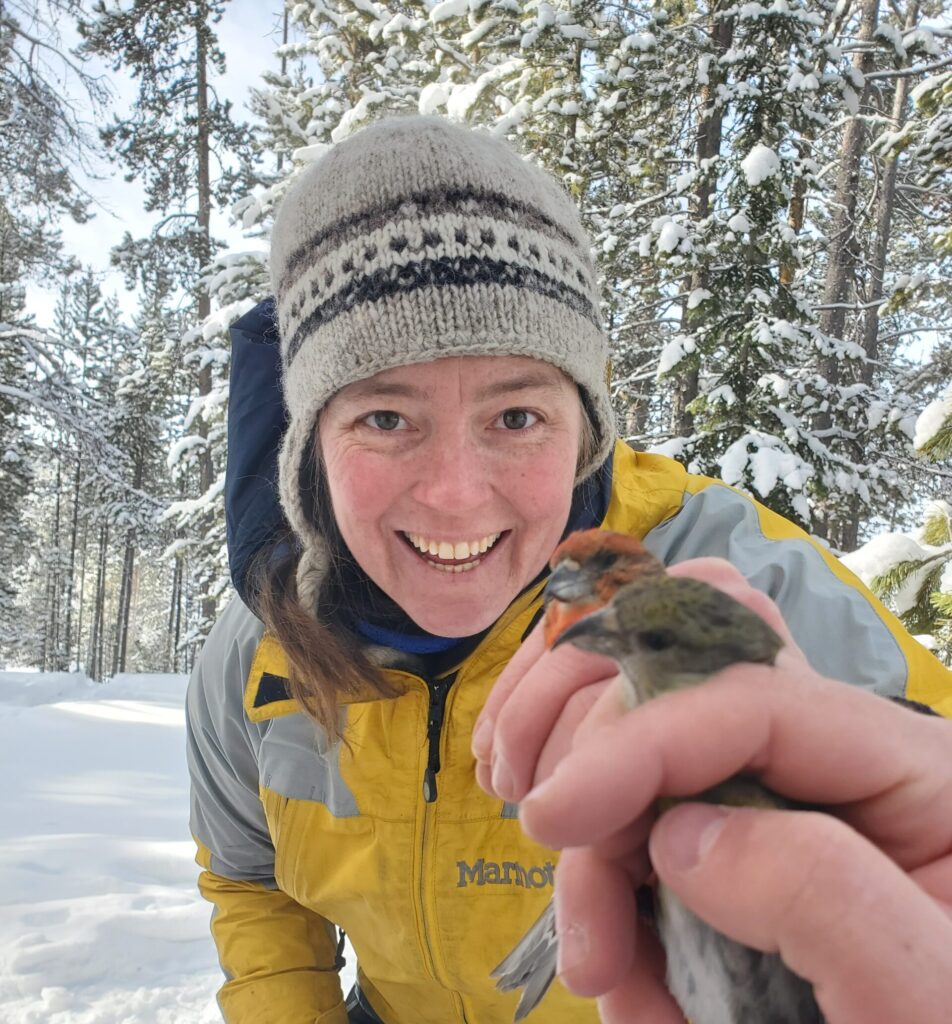Written by Ben Sonnenberg (Post-Doctoral Scholar at Oregon State University)
One snowshoe in front of other takes us on the painful but beautiful climb into the snow-laden forests of Grand Teton National Park. Wistful thoughts flick back to the temperatures of our beds at the Murie Ranch as the -20 ℉ morning air turns out breath to ice. We reach out stashed wildlife tracking antenna and go to work.


Alex Jahn, a Research Associate at Oregon State, is wearing the yellow jacket while out in the field for research. Benjamin Sonnenberg is wearing the blue backpack, exploring the terrain and observing the natural world.
Why are three scientists from Oregon State University hiking up Signal Mountain at 6:30 am in freezing February temperatures? Well, it’s for the birds-or in our case, a very specific bird. The Red Crossbill is a small charismatic finch species found in coniferous forests across the northern hemisphere. These aptly named songbirds sport crossed bill tips which enable them to forage on (among other things) closed conifer cones, reaching seeds often inaccessible to others. However, the tip of the bill is the tip of the iceberg when it comes to the unique natural history and potential scientific insights these birds hold.


A close-up of two crossbills: the male (red) and the female (yellow), highlighting the species’ vibrant coloration.
One claim to fame of the crossbill is the ability to reproduce in harsh winter environments. If the conditions are right (often related to food availability), crossbills will nest in August BUT again in February, despite the vast differences in temperature and precipitation. How do they manage? What is the cost? Well, that is a mystery that Dr. Jamie Cornelius has been unraveling in the Grand Tetons since 2009. The continuation of this long-term project is what brought us to Jackson, Wyoming in February 2025.
So how does a field biologist go about measuring the cost of living and thriving in the wintery wonderland that is a Rocky Mountain winter? One clever method is counting the heartbeats of free-living animals. Jamie is the master at attaching tiny transmitters to crossbills which then relay to a tracking antenna and receiving units carried by the team on the ground. These signals can then be coaxed into revealing the number of heartbeats that a crossbill must maintain across different seasons, temperatures, or nesting attempts, giving insight into the physiological demands on these birds.
Resting winter heart rates for crossbills range from 11-14 beats per second! During summer this is reduced to 6-8 beats per second. Why is this important? It allows us to measure the energetic investment required for not only survival but for reproduction. Understanding these physiological requirements for wild animal populations can not only aid in the understanding of basic biological processes but inform when these animals may by in trouble.
Collecting this data requires grit and determination. If birds equipped with transmitters fly too far out of reach of the receivers we lose data, which means that we must follow these animals around the forest as they go about their day high above us. During this process, we collect detailed information about foraging rates, social interactions, and all other behavior that we can absorb.
This winter on Signal Mountain was challenging for crossbills. We watched as birds struggled to extract any and all seeds from very old, grey serotinous lodgepole cones. Normally, crossbills do not forage on such cones as they are sealed with resin and only open from heat of forest fires. This tells us that this was a poor cone production year from the Lodgepole pine tree and that there were hardly any new, nonserotinous cones with easier access to fresh pine nuts. The birds we tracked moved from tree to tree with very little time to do anything else but eat. Needless to say, this was a year that we detected no breeding activity for the Tetons.
Projects like this one require years of effort, persistence, and many helping hands. We cannot thank the Teton Science School enough for opening a cabin at the Murie Ranch for our team to use as a homebase this winter. The Murie Ranch itself is often a bustling home for crossbills, but this winter they made us chase them around Signal Mountain. As Jamie says, “Never trust a bird! Particularly a Red Crossbill.” But years like this one continually adds to our understanding of natural communities, how each species fits within these mosaics, and how one species can lead to insights into the health and well-being of the whole ecosystem.


